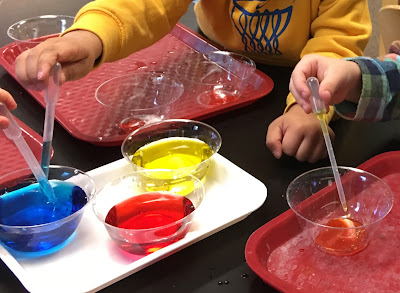When I was a joint MakerSpace teacher + librarian, I loved using books as my jumping off points for MakerSpace lessons. Books are my comfort zone, and reading a book aloud to start a lesson is a great way to introduce a concept and get everyone on topic. These "lessons" don't have to be done for an entire classroom, and don't even have to be done the way I outline them here, but I thought it would be something fun to share.
To start it all off, considering this time of year, I knew I should use
The Great Santa Stakeout by Betsy Bird, illustrated by Dan Santat. I read it with my son and
reviewed it recently, and it inspired a lot of STEM-y thoughts for me.
First off, the front endpapers are blueprints of Freddy's plans to take a selfie with Santa. Looking over the blueprints is a great way to get a hint of what's going to happen in the story, but also a way to start a conversation about ideas. Lots of ideas can come to you and then float away if you don't do anything about them. But writing them down and drawing them out can help make them a reality.
The story itself breaks Freddy's plot down into steps. After looking at the front endpapers and reading the story, kids will have a plan for how they can make their idea seem more manageable by breaking it into bite-sized pieces. The back endpapers have [SPOILER ALERT!] more blueprints of Freddy's next idea, so kids can see how, if something doesn't work the first time, they can go back to it, tweak a few things, and try again.
This is, of course, the way scientists do experiments, but since it's demonstrated in such a fun way, with an entertaining story to go along with it, it might seem more inviting than a full-scale science project. Also, I think introducing the concept via a picture book will help younger readers with this skill.
With this foundation, there are so many ways to continue this on into STEM lessons. For example:
- students could pick their favorite celebrity/public figure and try to plot how they'd get a selfie. (I can see this being a great choice for my 4th-7th graders.)
- students can plot how they would sneak a peek at Santa. (This might be best for home lessons, unless your school or library allows Christmas/Santa books and programs. Or, if this is for older kids who don't believe anymore, it could possibly be allowed.)
- students can map out a building concept. My students always loved building challenges involving marshmallows and toothpicks. You could ask them to draw a blueprint of a building using # of marshmallows and # of toothpicks (limits always make it more challenging!). Have them pitch their drawings, then let them build what they planned. Set an additional challenge, like the structure has to stand on its own for 10 seconds. If they do it, hurrah! If not, have them go back to the drawing board and draft another set of blueprints. This could also be done as partners or small groups. NOTE: While the marshmallows and toothpicks are fun and look snowy to go along with the book's theme, you could always use blocks, Legos, paper, or any building material!
I also think that blueprints and diabolical plots automatically lend themselves to Rube Goldberg machines. Have students draw a blueprint of their own custom Rube Goldberg design, even if it's not something they can actually build with materials you have (or even materials that actually exist!). Start brainstorming with the end goal - for example, I want slime to land on the head of the next person who comes into the room. How do I accomplish this? Maybe by putting a bucket of slime on the door, but how would it balance without plopping down? How else could I get slime onto someone's head? Start with the end goal and work backwards. If you're using this for a lesson, give students a certain number of steps or actions they need to use. For example, if I need to have 5 actions in my machine, I can't just prop a bucket of slime on top of the door - I need four more actions to make this happen. That's a great way to get imaginations going.








